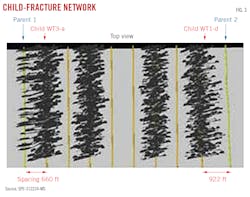Integrated geomechanical modeling predicts child-well fracture network
Chevron USA Inc. developed an extended embedded discrete fracture model (EDFM) which combines parent-well flow simulation with updated reservoir stress fields to predict growth of child-well fracture networks in relation to parent-well fractures. The model aids in well-pad design to minimize substandard child production due to interference with depleted parent wells.
Fracture model
Most recent wells drilled in the Permian basin are child wells which underperform compared with their parent wells. Premature child-well depletion occurs when the child-well fracture network encroaches within the drainage area of the parent. In addition to reduced production, intersecting fracture networks lead to sanding events and wellbore damage.
Reservoir simulation optimizes ideal locations for child wells relative to parents, but numerical flow simulators do not account for reservoir depletion, reservoir total stress changes, and reservoir effective stress changes from well interference. To address this deficiency, a coupled flow and geomechanics simulator accounts for stress magnitude and angle changes to predict fracture interference between parent and child.
The flow component of the model uses EDFM which separates fractures from the reservoir matrix for simpler mesh and reservoir modeling. Fracture aggregation and matrix coarsening approaches practically simulate a hydraulic network composed of multiple swarms of fracture elements. The model uses the unconventional fracture model (UFM) approach which couples discreet natural fractures with propagating hydraulic fractures to produce a tree-like branching fracture network (OGJ, Jul. 6, 2020, p. 39).
The matrix stress-change component ignores parent EDFM fractures because child wells are distant from parent-well fractures. Local stresses around the child well, therefore, only depend on pressure changes in the matrix.
Method
Fig. 1 shows the workflow for predicting impact of stress changes on child-well fracture growth. The workflow includes a high-resolution flow simulator, EDFM, geomechanics simulator, and hydraulic fracture simulator. Fracture simulation follows these sequential steps:
- History match parent-well production. An initial earth model is created containing only parent wells. Parent-well hydraulic fracture network is modeled using EDFM. The reservoir-simulator history matches production and estimates pressure changes around the parent.
- Update stress field. Stress magnitude and angle are updated using reservoir geomechanical properties and pressure changes from parent-well production. Only stress changes in the matrix grid are calculated as child wells are in areas with no preexisting hydraulic fractures.
- Stimulate child well. The child-well hydraulic fracture network is created based on the updated stress field.
- Forecast child, parent production. The child wells’ fractures are combined with the parent well’s fracture network to build a global EDFM model. The updated reservoir model predicts future production of both child and parent wells under different production conditions.
Fracture network analysis
The integrated parent-child EDFM model was applied to a phased development in Delaware basin. Fig. 2 shows placement of parent and child wells. Parent 1 started production in March 2018 and Parent 2 started production in December 2015. The study determined the effect of depletion on eight child wells in the adjacent formation. Four child wells are at similar depth to the parent wells (WT3 series), and four are slightly higher (WT1 series).
A probabilistic modeling approach evaluated uncertainty in subsurface parameters. Among 87 scenarios which varied permeability, porosity, water saturation, pore pressure, stress magnitude, anisotropy, Young’s modulus, and Poisson’s ratio, two models were selected for calibration with production data from the parent wells. The workflow updated the stress field based on parent depletion. The most significant changes in the new stress field were around parent wells.
Fig. 3 shows the fracture network from stimulated child wells. Child wells at the edges, near parent wells, have asymmetric fractures tending towards the parents. The fractures of child well WT3-a are predicted to intersect with the parent well 660 ft away. Well WT1-d should not intersect its nearest parent, 922 ft away.
Reservoir-flow simulation quantified depletion effects with two scenarios. A base case contained eight child wells producing from the original pressure field where the initial stress field dictated child-well hydraulic fracture geometry. A depleted case used a stress field resulting from the depleted parent wells based on their production histories up to January 2021. The fracture network created for child wells determined child-well production based on the depleted parent-induced stress field.
Fig. 4 compares child production between the base and depleted cases, and the table summarizes the percent decrease in child-well production between these cases. Depletion impact ratios range from 1-15%, with Well WT3-a, closest to a parent, experiencing the highest impact from depletion. Based on these results, one child well was eliminated from the field development program to mitigate parent-well depletion effects.
Based on “Integrating Geomechanics Studies to Shale and Tight Phased Development – Application to Delaware Basin,” SPE Reservoir Simulation Conference, Galveston, Tex., Mar. 28-30, 2023.
About the Author
Alex Procyk
Upstream Editor
Alex Procyk is Upstream Editor at Oil & Gas Journal. He has also served as a principal technical professional at Halliburton and as a completion engineer at ConocoPhillips. He holds a BS in chemistry (1987) from Kent State University and a PhD in chemistry (1992) from Carnegie Mellon University. He is a member of the Society of Petroleum Engineers (SPE).




